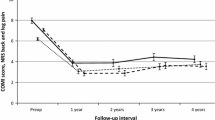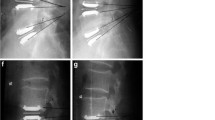Abstract
The existence and importance of an accelerated adjacent segment disc degeneration (ASD) after lumbar fusion have previously not been demonstrated by RCTs. The objectives of this study were, to determine whether lumbar fusion in the long term accelerates degenerative changes in the adjacent disc and whether this affects the outcome, by using a prospective randomised design. A total of 111 patients, aged 18–55, with isthmic spondylolisthesis were randomised to exercise (EX, n = 34) or posterolateral fusion (PLF, n = 77), with (n = 37) or without pedicle screw instrumentation (n = 40). The minimum 10 years FU rate was 72%, with a mean FU time of 12.6 years (range 10–17 years). Three radiographic methods of ASD quantification were used, i.e. two digital radiographic measurement methods and the semi quantitative UCLA grading scale. One digital measurement method showed a mean disc height reduction by 2% in the EX group and by 15% in the PLF group (p = 0.0016), and the other showed 0.5 mm more disc height reduction in the PLF compared to the Ex group (ns). The UCLA grading scale showed normal discs in 100% of patients in the EX group, compared to 62% in the PLF group (p = 0.026). There were no significant differences between instrumented and non-instrumented patients. In patients with laminectomy we found a significantly higher incidence of ASD compared to non laminectomised patients (22/47 vs. 2/16 respectively, p = 0.015). In the longitudinal analysis, the posterior and anterior disc heights were significantly reduced in the PLF group, whereas in the EX group only the posterior disc height was significantly reduced. Except for global outcome, which was significantly better for patients without ASD, the clinical outcome was not statistically different in patients with and without ASD. In conclusion, the long-term RCT shows that fusion accelerates degenerative changes at the adjacent level compared with natural history. The study suggests that not only fusion, but also laminectomy may be of pathogenetic importance. The clinical importance of ASD seems limited, with only the more severe forms affecting the outcome.



Similar content being viewed by others
References
Andersen T, Videbaek TS, Hansen ES, Bunger C, Christensen FB (2008) The positive effect of posterolateral lumbar spinal fusion is preserved at long-term follow-up: a RCT with 11–13 year follow-up. Eur Spine J 17:272–280. doi:10.1007/s00586-007-0494-8
Axelsson P, Johnsson R, Stromqvist B (2000) Is there increased intervertebral mobility in isthmic adult spondylolisthesis? A matched comparative study using roentgen stereophotogrammetry. Spine 25:1701–1703. doi:10.1097/00007632-200007010-00014
Axelsson P, Johnsson R, Stromqvist B (1997) The spondylolytic vertebra and its adjacent segment: mobility measured before and after posterolateral fusion. Spine 22:414–417. doi:10.1097/00007632-199702150-00012
Axelsson P Jr, Stromqvist B (2007) Adjacent segment hypermobility after lumbar spine fusion: no association with progressive degeneration of the segment 5 years after surgery. Acta Orthop 78:834–839. doi:10.1080/17453670710014635
Battie MC, Videman T, Levalahti E, Gill K, Kaprio J (2007) Heritability of low back pain and the role of disc degeneration. Pain 131:272–280. doi:10.1016/j.pain.2007.01.010
Bushell GR, Ghosh DP, Taylor TK, Sutherland JM, Braund KG (1978) The effect of spinal fusion on the collagen and proteoglycans of the canine intervertebral disc. J Surg Res 25:61–69. doi:10.1016/0022-4804(78)90159-2
Cheh G, Bridwell KH, Lenke LG, Buchowski JM, Daubs MD, Kim Y, Baldus C (2007) Adjacent segment disease followinglumbar/thoracolumbar fusion with pedicle screw instrumentation: a minimum 5-year follow-up. Spine 32:2253–2257
Chen CS, Cheng CK, Liu CL, Lo WH (2001) Stress analysis of the disc adjacent to interbody fusion in lumbar spine. Med Eng Phys 23:483–491. doi:10.1016/S1350-4533(01)00076-5
Dekutoski MB, Schendel MJ, Ogilvie JW, Olsewski JM, Wallace LJ, Lewis JL (1994) Comparison of in vivo and in vitro adjacent segment motion after lumbar fusion. Spine 19:1745–1751. doi:10.1097/00007632-199408000-00015
Eck JC, Humphreys SC, Hodges SD (1999) Adjacent-segment degeneration after lumbar fusion: a review of clinical, biomechanical, and radiologic studies. Am J Orthopedics (Belle Mead NJ) 28:336–340
Ekman P, Moller H, Hedlund R (2005) The long-term effect of posterolateral fusion in adult isthmic spondylolisthesis: a randomized controlled study. Spine J 5:36–44. doi:10.1016/j.spinee.2004.05.249
Etebar S, Cahill DW (1999) Risk factors for adjacent-segment failure following lumbar fixation with rigid instrumentation for degenerative instability. J Neurosurg 90:163–169
Fairbank JCTDJ, Couper J, O’Brien JP (1980) The Oswestry low back pain disability questionaire. Physiotherapy 66:271–273
Frobin W, Brinckmann P, Biggemann M, Tillotson M, Burton K (1997) Precision measurement of disc height, vertebral height and sagittal plane displacement from lateral radiographic views of the lumbar spine. Clin Biomech (Bristol, Avon) 12(Suppl 1):S1–S63. doi:10.1016/S0268-0033(96)00067-8
Frymoyer JW, Hanley EN Jr, Howe J, Kuhlmann D, Matteri RE (1979) A comparison of radiographic findings in fusion and nonfusion patients ten or more years following lumbar disc surgery. Spine 4:435–440. doi:10.1097/00007632-197909000-00008
Ghiselli G, Wang JC, Bhatia NN, Hsu WK, Dawson EG (2004) Adjacent segment degeneration in the lumbar spine. J Bone Joint Surg Am 86-A:1497–1503
Goto K, Tajima N, Chosa E, Totoribe K, Kubo S, Kuroki H, Arai T (2003) Effects of lumbar spinal fusion on the other lumbar intervertebral levels (three-dimensional finite element analysis). J Orthop Sci 8:577–584. doi:10.1007/s00776-003-0675-1
Ha KY, Schendel MJ, Lewis JL, Ogilvie JW (1993) Effect of immobilization and configuration on lumbar adjacent-segment biomechanics. J Spinal Disord 6:99–105. doi:10.1097/00002517-199304000-00002
Hambly MF, Wiltse LL, Raghavan N, Schneiderman G, Koenig C (1998) The transition zone above a lumbosacral fusion. Spine 23:1785–1792. doi:10.1097/00007632-199808150-00012
Hilibrand AS, Robbins M (2004) Adjacent segment degeneration and adjacent segment disease: the consequences of spinal fusion? Spine J 4:190S–194S. doi:10.1016/j.spinee.2004.07.007
Korovessis P, Papazisis Z, Koureas G, Lambiris E (2004) Rigid, semirigid versus dynamic instrumentation for degenerative lumbar spinal stenosis: a correlative radiological and clinical analysis of short-term results. Spine 29:735–742. doi:10.1097/01.BRS.0000112072.83196.0F
Kumar MN, Jacquot F, Hall H (2001) Long-term follow-up of functional outcomes and radiographic changes at adjacent levels following lumbar spine fusion for degenerative disc disease. Eur Spine J 10:309–313. doi:10.1007/s005860000207
Lai PL, Chen LH, Niu CC, Fu TS, Chen WJ (2004) Relation between laminectomy and development of adjacent segment instability after lumbar fusion with pedicle fixation. Spine 29:2527–2532. doi:10.1097/01.brs.0000144408.02918.20 discussion 2532
Lazennec JY, Ramare S, Arafati N, Laudet CG, Gorin M, Roger B, Hansen S, Saillant G, Maurs L, Trabelsi R (2000) Sagittal alignment in lumbosacral fusion: relations between radiological parameters and pain. Eur Spine J 9:47–55. doi:10.1007/s005860050008
Lee CK (1988) Accelerated degeneration of the segment adjacent to a lumbar fusion. Spine 13:375–377. doi:10.1097/00007632-198803000-00029
Lehmann TR, Spratt KF, Tozzi JE, Weinstein JN, Reinarz SJ, el-Khoury GY, Colby H (1987) Long-term follow-up of lower lumbar fusion patients. Spine 12:97–104. doi:10.1097/00007632-198703000-00004
Lenke LG, Bridwell KH, Bullis D, Betz RR, Baldus C, Schoenecker PL (1992) Results of in situ fusion for isthmic spondylolisthesis. J Spinal Disord 5:433–442
Leong JC, Chun SY, Grange WJ, Fang D (1983) Long-term results of lumbar intervertebral disc prolapse. Spine 8:793–799. doi:10.1097/00007632-198310000-00018
Levin DA, Hale JJ, Bendo JA (2007) Adjacent segment degeneration following spinal fusion for degenerative disc disease. Bull NYU Hosp Jt Dis 65:29–36
Luk KD, Lee FB, Leong JC, Hsu LC (1987) The effect on the lumbosacral spine of long spinal fusion for idiopathic scoliosis: a minimum 10-year follow-up. Spine 12:996–1000. doi:10.1097/00007632-198712000-00010
Miyakoshi N, Abe E, Shimada Y, Okuyama K, Suzuki T, Sato K (2000) Outcome of one-level posterior lumbar interbody fusion for spondylolisthesis and postoperative intervertebral disc degeneration adjacent to the fusion. Spine 25:1837–1842. doi:10.1097/00007632-200007150-00016
Moller H, Hedlund R (2000) Instrumented and noninstrumented posterolateral fusion in adult spondylolisthesis—a prospective randomized study: part 2. Spine 25:1716–1721. doi:10.1097/00007632-200007010-00017
Moller H, Sundin A, Hedlund R (2000) Symptoms, signs, and functional disability in adult spondylolisthesis. Spine 25:683–689. doi:10.1097/00007632-200003150-00006 discussion 690
Oda I, Cunningham BW, Buckley RA, Goebel MJ, Haggerty CJ, Orbegoso CM, McAfee PC (1999) Does spinal kyphotic deformity influence the biomechanical characteristics of the adjacent motion segments? An in vivo animal model. Spine 24:2139–2146. doi:10.1097/00007632-199910150-00014
Okuda S, Iwasaki M, Miyauchi A, Aono H, Morita M, Yamamoto T (2004) Risk factors for adjacent segment degeneration after PLIF. Spine 29:1535–1540. doi:10.1097/01.BRS.0000131417.93637.9D
Olsewski JM, Schendel MJ, Wallace LJ, Ogilvie JW, Gundry CR (1996) Magnetic resonance imaging and biological changes in injured intervertebral discs under normal and increased mechanical demands. Spine 21:1945–1951. doi:10.1097/00007632-199609010-00001
Park P, Garton HJ, Gala VC, Hoff JT, McGillicuddy JE (2004) Adjacent segment disease after lumbar or lumbosacral fusion: review of the literature. Spine 29:1938–1944. doi:10.1097/01.brs.0000137069.88904.03
Pearson ASD, Wharton N, Genuario J, McGough W, Spratt K (2007) Precision of lumbar intervertebral measurements: does a computer assisted technique improve reliability? Abstract at: The International Society for the Study of the Lumbar Spine (ISSLS). Hong Kong, China
Pellise F, Hernandez A, Vidal X, Minguell J, Martinez C, Villanueva C (2007) Radiologic assessment of all unfused lumbar segments 7.5 years after instrumented posterior spinal fusion. Spine 32:574–579. doi:10.1097/01.brs.0000256875.17765.e6
Penta M, Sandhu A, Fraser RD (1995) Magnetic resonance imaging assessment of disc degeneration 10 years after anterior lumbar interbody fusion. Spine 20:743–747. doi:10.1097/00007632-199503150-00018
Phillips FM, Reuben J, Wetzel FT (2002) Intervertebral disc degeneration adjacent to a lumbar fusion: an experimental rabbit model. J Bone Joint Surg Br 84:289–294. doi:10.1302/0301-620X.84B2.11937
Pope MH, Wilder DG, Matteri RE, Frymoyer JW (1977) Experimental measurements of vertebral motion under load. Orthop Clin North Am 8:155–167
Salen BA, Spangfort EV, Nygren AL, Nordemar R (1994) The disability rating index: an instrument for the assessment of disability in clinical settings. J Clin Epidemiol 47:1423–1435. doi:10.1016/0895-4356(94)90086-8
Schulte TL, Leistra F, Bullmann V, Osada N, Vieth V, Marquardt B, Lerner T, Liljenqvist U, Hackenberg L (2007) Disc height reduction in adjacent segments and clinical outcome 10 years after lumbar 360 degrees fusion. Eur Spine J 16(12):2152–2158
Seitsalo S, Schlenzka D, Poussa M, Osterman K (1997) Disc degeneration in young patients with isthmic spondylolisthesis treated operatively or conservatively: a long-term follow-up. Eur Spine J 6:393–397. doi:10.1007/BF01834066
Throckmorton TW, Hilibrand AS, Mencio GA, Hodge A, Spengler DM (2003) The impact of adjacent level disc degeneration on health status outcomes following lumbar fusion. Spine 28:2546–2550. doi:10.1097/01.BRS.0000092340.24070.F3
Umehara S, Zindrick MR, Patwardhan AG, Havey RM, Vrbos LA, Knight GW, Miyano S, Kirincic M, Kaneda K, Lorenz MA (2000) The biomechanical effect of postoperative hypolordosis in instrumented lumbar fusion on instrumented and adjacent spinal segments. Spine 25:1617–1624. doi:10.1097/00007632-200007010-00004
Wai EK, Santos ER, Morcom RA, Fraser RD (2006) Magnetic resonance imaging 20 years after anterior lumbar interbody fusion. Spine 31:1952–1956. doi:10.1097/01.brs.0000228849.37321.a8
Van Horn JR, Bohnen LM (1992) The development of discopathy in lumbar discs adjacent to a lumbar anterior interbody spondylodesis: a retrospective matched-pair study with a postoperative follow-up of 16 years. Acta Orthop Belg 58:280–286
Weinhoffer SL, Guyer RD, Herbert M, Griffith SL (1995) Intradiscal pressure measurements above an instrumented fusion: a cadaveric study. Spine 20:526–531. doi:10.1097/00007632-199503010-00004
Videbaek TS, Christensen FB, Soegaard R, Hansen ES, Hoy K, Helmig P, Niedermann B, Eiskjoer SP, Bunger CE (2006) Circumferential fusion improves outcome in comparison with instrumented posterolateral fusion: long-term results of a randomized clinical trial. Spine 31:2875–2880. doi:10.1097/01.brs.0000247793.99827.b7
Wiltse LL, Radecki SE, Biel HM, DiMartino PP, Oas RA, Farjalla G, Ravessoud FA, Wohletz C (1999) Comparative study of the incidence and severity of degenerative change in the transition zones after instrumented versus noninstrumented fusions of the lumbar spine. J Spinal Disord 12:27–33. doi:10.1097/00002517-199902000-00004
Yang JY, Lee JK, Song HS (2008) The impact of adjacent segment degeneration on the clinical outcome after lumbar spinal fusion. Spine 33:503–507. doi:10.1097/BRS.0b013e31817e6974
Zhao K, Yang C, Zhao C, An KN (2005) Assessment of non-invasive intervertebral motion measurements in the lumbar spine. J Biomech 38:1943–1946. doi:10.1016/j.jbiomech.2004.07.029
Author information
Authors and Affiliations
Corresponding author
Rights and permissions
About this article
Cite this article
Ekman, P., Möller, H., Shalabi, A. et al. A prospective randomised study on the long-term effect of lumbar fusion on adjacent disc degeneration. Eur Spine J 18, 1175–1186 (2009). https://doi.org/10.1007/s00586-009-0947-3
Received:
Revised:
Accepted:
Published:
Issue Date:
DOI: https://doi.org/10.1007/s00586-009-0947-3




